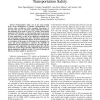Free Online Productivity Tools
i2Speak
i2Symbol
i2OCR
iTex2Img
iWeb2Print
iWeb2Shot
i2Type
iPdf2Split
iPdf2Merge
i2Bopomofo
i2Arabic
i2Style
i2Image
i2PDF
iLatex2Rtf
Sci2ools
CORR
2008
Springer
2008
Springer
Impact of Vehicular Communications Security on Transportation Safety
Transportation safety, one of the main driving forces of the development of vehicular communication (VC) systems, relies on high-rate safety messaging (beaconing). At the same time, there is consensus among authorities, industry, and academia on the need to secure VC systems. With specific proposals in the literature, a critical question must be answered: can secure VC systems be practical and satisfy the requirements of safety applications, in spite of the significant communication and processing overhead and other restrictions security and privacy-enhancing mechanisms impose? To answer this question, we investigate in this paper the following three dimensions for secure and privacy-enhancing VC schemes: the reliability of communication, the processing overhead at each node, and the impact on a safety application. The results indicate that with the appropriate system design, including sufficiently high processing power, applications enabled by secure VC can be in practice as effective...
CORR 2008 | Education | Main Driving Forces | Safety | VC Systems |
| Added | 09 Dec 2010 |
| Updated | 09 Dec 2010 |
| Type | Journal |
| Year | 2008 |
| Where | CORR |
| Authors | Panos Papadimitratos, Giorgio Calandriello, Jean-Pierre Hubaux, Antonio Lioy |
Comments (0)

